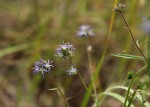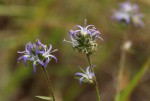Wahlenbergia capitata
Selected images: Click on each image to see a larger version and details of the record View all images (7)
Detailed records: Display species records QDS maps by: Google Maps Point records by Google Maps
Species details: Click on each item to see an explanation of that item (Note: opens a new window)
| Synonyms: |
Lightfootia bequaertii De Wild. & Ledoux Lightfootia capitata Baker Lightfootia elegans Gilli Lightfootia glomerata Engl. var. subspicata Engl. Lightfootia glomerata Engl. var. capitata (Baker) Lambinon |
| Common names: | |
| Frequency: | |
| Status: | Native |
| Description: |
Annual or perennial erect or somewhat sprawling herb. Leaves alternate, linear to narrowly lanceolate, sessile, hirsute on the veins beneath; margin dentate and ± dentate. Inflorescence a terminal head. Calyx lobes 2-4 mm. Corolla split almost to base, into linear lobes, blue, white or mauve. Ovary 3-locular, semi-inferior; style with 3 lobes. |
| Type location: |
Malawi |
| Notes: | |
| Derivation of specific name: | capitata: in the form of a head, capitate |
| Habitat: | In grassland and woodland and in formerly cultivated areas, often preferring sandy soils |
| Altitude range: (metres) | |
| Flowering time: | |
| Worldwide distribution: | Uganda, Tanzania, DRC, Rwanda, Burundi, Malawi, Mozambique, Zambia and Zimbabwe. |
| FZ divisions: | N,T,MS |
| Growth form(s): | |
| Endemic status: | |
| Red data list status: | |
| Insects associated with this species: | |
| Spot characters: | Display spot characters for this species |
| Images last updated: | Wednesday 21 May 2014 |
| Literature: |
Baumann, G. (2005). Photographic Guide to Wildflowers of Malawi Wildlife and Environmental Society of Malawi Pages 158 - 159. (Includes a picture). Burrows, J.E. & Willis, C.K. (eds) (2005). Plants of the Nyika Plateau Southern African Botanical Diversity Network Report No. 31 SABONET, Pretoria Page 123. Da Silva, M.C., Izidine, S. & Amude, A.B. (2004). A preliminary checklist of the vascular plants of Mozambique. Southern African Botanical Diversity Network Report No. 30 Sabonet, Pretoria Page 40. Mapaura, A. & Timberlake, J. (eds) (2004). A checklist of Zimbabwean vascular plants Southern African Botanical Diversity Network Report No. 33 Sabonet, Pretoria and Harare Page 31. Ntore, S. & al. (2024). Checklist of the vascular plants of Burundi Page 78. Phiri, P.S.M. (2005). A Checklist of Zambian Vascular Plants Southern African Botanical Diversity Network Report No. 32 Page 38. Reekmans, M. (1985). Campanulaceae Flore du Rwanda Spermatophytes Volume III Page 520. (Includes a picture). Strugnell, A.M. (2006). A Checklist of the Spermatophytes of Mount Mulanje, Malawi Scripta Botanica Belgica 34 National Botanic Garden of Belgium Page 64. Thulin, M. (1977). Campanulaceae Flore d'Afrique Centrale Botanic Garden Meise, Belgium Pages 21 - 23. (Includes a picture). Thulin, M. (1983). Campanulaceae Flora Zambesiaca 7(1) Pages 99 - 101. (Includes a picture). |
Other sources of information about Wahlenbergia capitata:
Our websites:
Flora of Burundi: Wahlenbergia capitataFlora of the DRC: Wahlenbergia capitata
Flora of Malawi: Wahlenbergia capitata
Flora of Rwanda: Wahlenbergia capitata
Flora of Zambia: Wahlenbergia capitata
Flora of Zimbabwe: Wahlenbergia capitata
External websites:
African Plants: A Photo Guide (Senckenberg): Wahlenbergia capitataAfrican Plant Database: Wahlenbergia capitata
BHL (Biodiversity Heritage Library): Wahlenbergia capitata
EOL (Encyclopedia of Life): Wahlenbergia capitata
GBIF (Global Biodiversity Information Facility): Wahlenbergia capitata
Google: Web - Images - Scholar
iNaturalist: Wahlenbergia capitata
IPNI (International Plant Names Index): Wahlenbergia capitata
JSTOR Plant Science: Wahlenbergia capitata
Mansfeld World Database of Agricultural and Horticultural Crops: Wahlenbergia capitata
Plants of the World Online: Wahlenbergia capitata
Tropicos: Wahlenbergia capitata
Wikipedia: Wahlenbergia capitata

